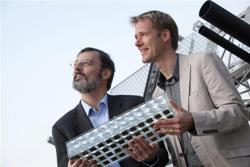May 20 2010
Climate change and ever scarcer fossil resources will determine the energy mix of the future. Solar energy will play an integral role in this regard.
 Dr. Andreas Bett and Dr. Frank Dimroth (left to right) working on highest-efficiency solar cells and concentrating solar modules to make solar energy cheaper.
Dr. Andreas Bett and Dr. Frank Dimroth (left to right) working on highest-efficiency solar cells and concentrating solar modules to make solar energy cheaper.
Dr. Andreas Bett and Dr. Frank Dimroth of the Fraunhofer Institute for Solar Energy Systems ISE in Freiburg developed metamorphic triple-junction solar cell consisting of III-V compound semiconductors: gallium indium phosphide, gallium indium arsenide and germanium. This special structure makes it possible to optimize the use of almost the entire solar spectrum for energy production. Researchers have been able to transform more sunlight into power than ever before, at a record degree of efficiency of 41.1 percent. In recognition of their work, they are receiving the 2010 Joseph von Fraunhofer Prize.
This high degree of efficiency is made possible by stacking multiple top-quality solar cells on top of each other. „Our triple solar cell consists of more than 20 individual layers, all of which we have optimized," says Dr. Frank Dimroth. „We have improved both the structure of the semiconductor as well as the material quality, the metal contacts and the antireflection coatings, in order to arrive at this result." Originally, these compound solar cells were engineered for use in space - most satellites in space are loaded with them. They supply the operating power. Since the production process is comparatively expensive, these cells had not been used on earth before. The combination of highly efficient cells with a lens amplifier ensures that - in comparison to conventional solar modules - only one five-hundredth of the semiconductor surface will be needed. The cells within their own specially designed concentrator modules measure only three square millimeters in size. A Fresnel lens is situated over these mini solar cells, at a distance of approximately ten centimeters. This configuration concentrates the sunlight by a factor of 400 to 500. To prevent the cells from overheating, they are attached to a copper support that distributes the heat sufficiently well. Thus, passive cooling of the solar cells suffices. „Thanks to this construction, we were able to produce modules with a degree of efficiency in excess of 29 percent," says Dr. Andreas Bett. These modules have been on the market since 2007 under the brand name FLATCON®, and are being used in a solar park in Spain, for example.
To facilitate the swift transfer of technology from the laboratory to industry, a demonstration laboratory was constructed at the institute, with the same machines that would be used in industry. Here, researchers are developing and testing production processes for the construction and connection technology, module integration and quality control. A spin-off of ISE – Concentrix Solar GmbH – produces the concentrator systems that, for example, feed solar power into the grid from a solar park in Spain with 25 percent system efficiency. For the development of metamorphic triple-junction solar cells, the team has been closely collaborating for years with AZUR Space Solar Power in Heilbronn, the leading European manufacturer of solar cells for space. This partner is aiming to bring the highly efficient solar cells to the market by 2011.